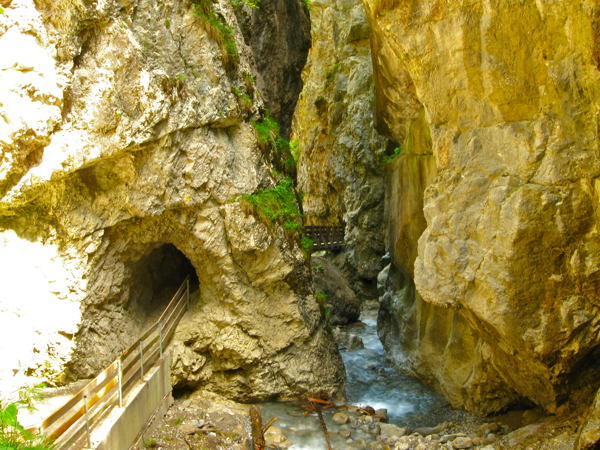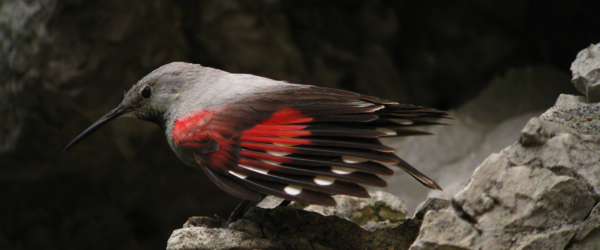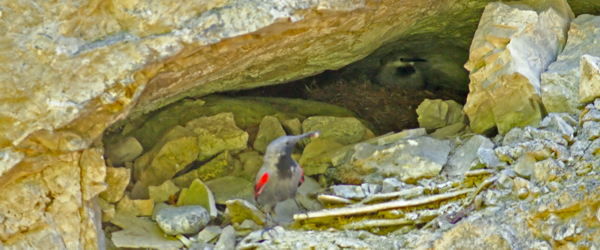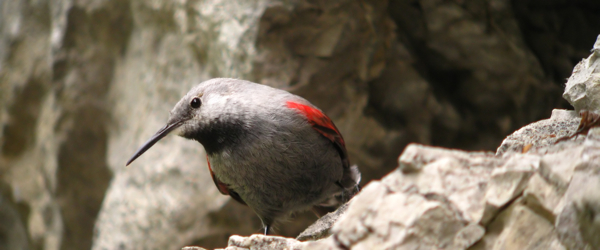When I think of the birds of the Alps, the first names that come to mind are Alpine Chough, Bearded Vulture, Snowfinch, Alpine Accentor and – of course – the Wallcreeper. When I first moved to Tirol, the Wallcreeper Tichodroma muraria was probably the number one bird I wanted to find – everything I had heard or seen about it was extraordinary. A beautiful pale grey with crazy crimson wings. A fascinating nature and behaviour. And how any insectivore could eke out an existence on the cliffs of the high mountains was, quite simply, beyond me.
It took me two years of searching before I found my first Wallcreeper, this despite all the local ornithologists claiming that the best spot in the area was a 5min walk from my house. Hundreds of visits there turned up nothing but peace of mind (well, when you are sitting for hours staring at cliffs and listening to a brooke tumble by, there is not much else you can do but have the mind stilled).
In the beginning I chased every little tip I got about Wallcreepers (particularly during the breeding season) and eventually I got lucky and got a nest in a really really good spot – 35m (100ft) away and at eye level.
This was an awesome nest for we could see exactly what was happening a good foot in to the cliffs – it was really like having a look in to the private lives of a very secretive creature (none of the nests I have had subsequently have shown anywhere near this well). In the video you can see the male bringing in a variety of insect food (collected over the course of about 45mins) and fed to 4 hungry mouths. At one stage you see the female eat a faecal sack. Interestingly, at most Wallcreeper nests I have seen, I often saw the male flying off with faecal sacks and dropping them on the wing 30-50m from the nest. I wonder if this is a general phenomenon that the female tends to eat the faecal sack and the male carries it off…
Having now spent a good amount of time at Wallcreeper nests, I tried to find out what is known about their breeding and have come up rather empty. The only serious academic paper I have found is a 1975 paper (in German) by Hans Löhrl in the Journal of Ornithology.
female Wallcreeper on nest, male with a faecal sack
It seems it is only the female that prepares the nest, and there is often a 9-14 day break between the nest being ready, and the laying of the first eggs (Löhrl 1975). This is something that threw me completely off guard at the first Wallcreeper nest I was following because suddenly the birds were gone and I feared the worst – that the nest had been abandoned and that the birds were gone. Importantly, Wallcreepers will only attempt to nest once per year even if the clutch fails. I suppose this is because of the harshness of the ecosystem and the very short flourishing period in the high mountains. As far as I can tell, in Tirol (the Alps?), the vast majority of Wallcreepers are in the high Alpine zone (above 1800m) and have huge home ranges, freely wandering along cliff lines, making them generally very difficult to find. Nevertheless, the also seem to like narrow gorges, particularly with wet walls or waterfalls, and because these are oftentimes also at lower altitudes and are more accessible, this is where people normally see them.
 typical “low altitude” Wallcreeper habitat. lots of sheer cliffs and water.
typical “low altitude” Wallcreeper habitat. lots of sheer cliffs and water.
Despite now having seen many wallcreepers and having taken many thousands of photos, I still chase pretty much any rumour I hear of Wallcreepers. Some might say I am obsessed.
See more wallcreeper photos in my birdingblogs.com Wallcreeper post.
And on my Discovering Alpine Birds blog.
















Great Post would love to see one of these one day. Love the video.
The Handbook of the Birds of the World entry for the species/family has three pages of information on their breeding if you are interested. Its in volume 13.
Great photos by the way!
We can totally understand you having a bit of an obsession with these-not a bad thing, surely?!
@Craig, thanks.
@Duncan. good point, I have not looked at it for a while but they do a really good job of it (as with so many species). The Helm “Tits, Nuthatches and Treecreepers” also has some info but it is rather scant and with old references.
@Clare and Grant, obsession – like genius – is never purely good or purely bad but a crazy mixture of both.
We got ’em on factory walls in my town!
Great post and great birds!
One of the birds of the world that I’d most like to see, however unlikely that might be. Great post.
Nice pictures! I wondering what bird (if any) would fill a similar niche in the US?
Hi All, thanks for all your comments.
@YourBirdOasis, I do not know of any other species in a similar niche in the States. Off the top of my head, the only other bird in a similar niche that I can think of is the Rock Nuthatch which also feeds and nests in cliffs. Maybe someone else who stops by has a suggestion or two.